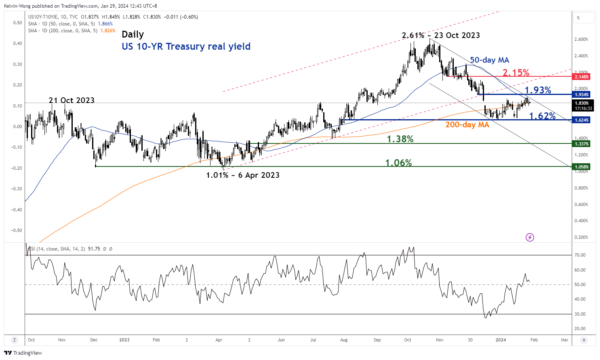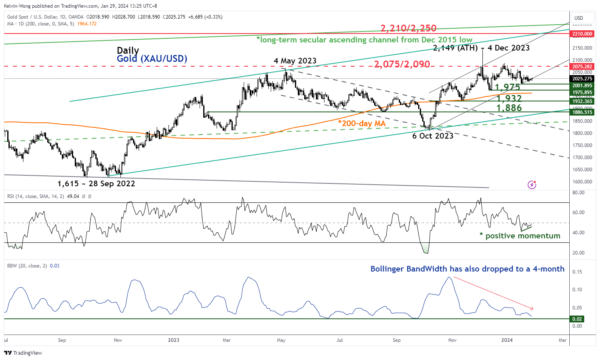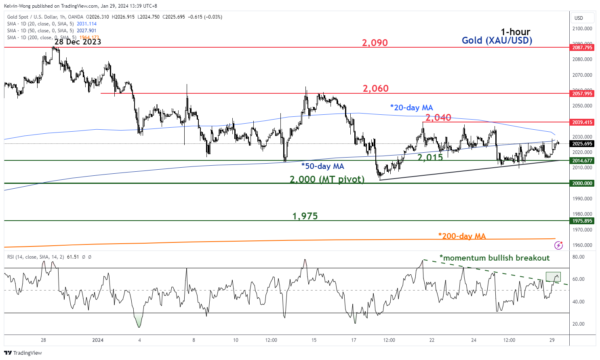- Higher US 10-year Treasury real yield and rising geopolitical risk premium have created a floor and cap for Gold (XAU/USD) at US$2,000 and US$2,040 respectively.
- Historical volatility of Gold (XAU/USD) has slipped to a 4-month low, increasing the odds of an impending volatility breakout scenario.
- The direction of the volatility breakout is likely to be reinforced by this Wednesday’s FOMC monetary policy guidance.
- Positive momentum has started to emerge ahead of FOMC.
In the past two weeks, Gold (XAU/USD) has reintegrated below its 20-day moving average but still managed to hold above the US$2,001 low printed on 17 January. Overall, its price actions have been sandwiched by opposing fundamental factors.
Negative factor – Higher US 10-year Treasury real yield
A slew of recent US economic data releases has indicated that the US economy has remained resilient, especially on consumer sentiment and spending where retail sales in December surged to an 11-month high at 5.6% y/y as well as a significant recovery in consumer sentiment at the start of the new year. The flash University of Michigan Consumer Sentiment survey data soared to 78.8 in January 2024, its highest level since July 2021, and surpassed expectations pegged at 70.
Given that the US economy appears to be still in a goldilocks-liked environment, there will be less justification for the US Federal Reserve to enact its first interest rate cut in the upcoming March FOMC meeting. Based on the CME FedWatch Tool inferred from 30-day Fed funds futures pricing data, the odds of a 25-basis point (bps) cut on the Fed funds rate in March have decreased to 47% at this time of the writing from around 70% chance recorded a month ago.

Fig 1: US 10-year Treasury real yield medium-term trend as of 29 Jan 2024 (Source: TradingView, click to enlarge chart)
This reduction in the pricing odds of the first Fed fund rate cut in March has led to an uptick in the US 10-year Treasury real yield which rose by 25 bps to hit almost a 1-month high of 1.90% on last Thursday, 25 January 2023. So far, the rally has been capped by its 50-day moving average which confluences with a near-term range resistance at 1.93%.
A firmer US 10-year Treasury real yield increases the opportunity cost of holding gold which in turn puts a cap on Gold (XAU/USD).
Positive factor – Rising geopolitical risk premium
The ongoing hostilities in the Middle East region and the Red Sea shipping route that are related to the ongoing Israel-Hamas war are showing no clear signs of abating.
Iran-backed militants have attacked and killed US troops stationed in Jordan via a drone assault and hit a fuel tanker in the Red Sea over the weekend marking a further escalation of tensions among the respective stakeholders.
Hence, a support or floor has been created at the US$2,000 psychological level for Gold (XAU/USD).
Impending volatility breakout, coiling up ahead of Fed FOMC

Fig 2: Gold (XAU/USD) medium-term & major trends as of 29 Jan 2024 (Source: TradingView, click to enlarge chart)

Fig 3: Gold (XAU/USD) minor short-term trend as of 29 Jan 2024 (Source: TradingView, click to enlarge chart)
In the lens of technical analysis, the 20-day rolling historical volatility in Gold (XAU/USD) has dropped to almost a 4-month low since late September 2023 as indicated by the Bollinger BandWidth which suggests that the price actions of Gold (XAU/USD) have compressed into a relatively low volatility environment that is ripe for a volatility breakout scenario.
The direction of the volatility breakout is likely to be reinforced by the Fed’s monetary policy guidance this coming Wednesday, 31 January via its policy statement and Fed Chair Powell’s press conference as the market has already fully priced in a stand pat outcome on its Fed funds rate at 5.25% to 5.50%.
Interestingly, positive momentum seems to be creeping back ahead of this week’s FOMC where the daily RSI momentum indicator has formed a higher low since 17 January 2024 at around the 50 level.
Therefore, there is a potential chance of a bullish volatility breakout scenario for Gold (XAU/USD) as long as US$2,000 key medium-term pivotal support holds and a break above US$2,040 sees the next intermediate resistances coming in at US$2,060 and US$2,090.
On the other hand, failure to hold at US$2,000 invalidates the bullish scenario for an extension of the corrective decline within its major uptrend phase to expose the next intermediate support at US$1,975 (close to the 200-day moving average).









